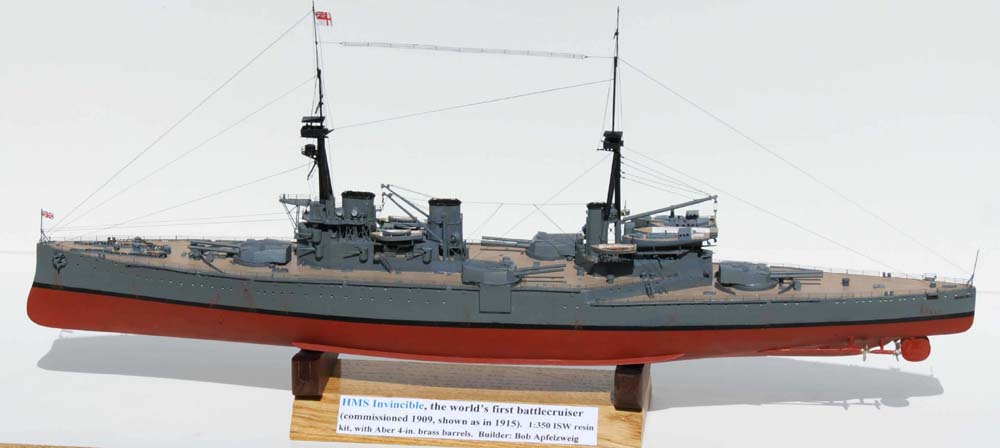
1/350 HMS Invincible (ISW)
|
by Robert Apfelzweig |

1/350 HMS Invincible (ISW)
I purchased this resin kit online from a private party several years ago, and just these past few months have gotten around to building it. ISW released this kit in 2005, so it is somewhat "transitional" in terms of how well the kit is prepared. The hull was excellently cast and required only a modest amount of putty-filling and sanding, and though several superstructure deck parts were badly warped, ISW's excellent customer service replaced them (and sent me many more extra parts) within a few days of my emailing them (thanks, Jon Warneke!). Instructions are crude photocopies, the parts are listed by name and sometimes by number but not illustrated except in the three crude assembly diagrams, and a number of parts are included but not listed and there are no instructions for how or where to install them. The original kit was supplied with rather useless white metal 12-in. gun barrels, and the replacement package included better-formed resin ones, but I actually used left-over plastic barrels from Zvezda's HMS Dreadnought kit, since they compared very favorably with the brass barrels supplied by the HMS Dreadnought's Pontos upgrade set. The 4-in. brass barrels on the Invincible were from Aber, which sells them in packages of 16. I painted the ship in Tamiya neutral gray XF-53 (sometimes mixed with the slightly lighter Tamiya Ocean Grey XF-82) and sprayed the upper hull with Tamiya Ocean Grey (AS-10). The deck was airbrushed with Tamiya Deck Tan (to which I had added a small amount of Tamiya flat brown), the lower hull was painted with WEM British Antifouling Red, and the boot topping and upper masts were painted in Tamiya flat black. Rigging was from stretched black plastic sprue. I modified the turrets so that they can rotate, gluing plastic rods in the turret bottoms that insert into holes in the center of each barbette). Despite the kit and ISW supplying me with at least a dozen resin tripod struts, all were variably warped, so I used similar-diameter brass rod cut to the resin struts' length; the resin vertical tripod legs were straight and, so, were used.
The HMS Invincible, commissioned in 1909, was the world's first battlecruiser, a hybrid concept from Britain's Admiral Jackie Fisher (who had more recently promoted the new Dreadnought type all-big gun battleships). A battlecruiser had the heavy armament of a battleship (though usually with fewer guns) but with thinner armor, and with greater speed than a contemporary armored cruiser -- which enabled this vessel, and its sistership HMS Inflexible, to chase down and sink the German armored cruisers Scharnhorst and Gneisenau in the Battle of the Falklands in December 1914. Unfortunately, the temptation to use battlecruisers as first-line combat ships, along with battleships, led to the loss of the Invincible and two other British battlecruisers at the Battle of Jutland in May 1916. Fighting against similarly armed but better protected German battlecruisers, the Invincible was struck by several 12-in. shells amidships, at least one of which penetrated her "Q" turret and ignited her midships powder magazines, blowing the ship apart and leaving just the separated bow and stern poking up above the water's surface. According to Wikipedia, some 1026 crewmembers were killed; of six survivors, five had been stationed up in the foremast spotting platform.
ISW's model of the Invincible has some accuracy issues in that the kit
supposedly represents the ship in her post-Falklands and pre-Jutland days
-- the 4-in. guns atop all four turrets had been removed and the eight
secondary guns in the forward bridge were now in casemates (additional,
separate casemates are supplied but there are no instructions as to how
to install them, though this is not difficult to discern). By 1915
her antitorpedo nets had also been removed (a broadside photo of her at
the Battle of the Falklands shows them already absent), which made this
aspect of the hull preparation much simpler. The forward funnel is taller
than the other two (a post-Falklands modification), though it does not
seem quite tall enough (it was 15 ft. higher on the actual ship).
And by 1915 the bridge seems to have been enlarged to include an enclosed,
windowed navigation deck, but the kit only supplies the older, pre-Falklands
structure without any windows.
